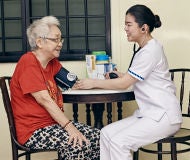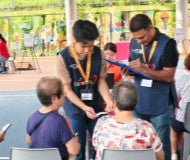What is - Autistic Spectrum Disorder (Child)
 Autistic spectrum disorder (ASD) is a complex disorder of the central nervous system, which often first appears as delayed speech in children around 18 months of age. The disorder exists at birth and can usually be reliably diagnosed by the time the child is three years old.
Autistic spectrum disorder (ASD) is a complex disorder of the central nervous system, which often first appears as delayed speech in children around 18 months of age. The disorder exists at birth and can usually be reliably diagnosed by the time the child is three years old.
Autism is one type of ASD that appears in early childhood — usually before age three. About 15 to 20 children in every 10,000 children are autistic. Boys are up to four times more likely to develop autism than girls.
Children with ASD develop normally into adults. However, they continue to have impaired social communication, interaction and fondness for repetitive actions. How the child turns out is usually determined by his or her cognitive and social abilities.
About 70% of children with ASD have developmental difficulties, with most requiring supervision at home and work. They enjoy a normal life expectancy, although some will have residual psychological problems (anxiety and depression) or seizures.
Autism may improve with appropriate education and therapy or as the child matures. Some eventually lead normal or near-normal lives, although they continue to show some social awkwardness.
Symptoms of Autistic Spectrum Disorder (Child)
Symptoms of Autistic Spectrum Disorder (Child) include:
Impairment of social communication- Delayed speech and language development
- Difficulty expressing oneself or understanding others’ feelings or thoughts
- Have difficulty using and reading gestures, facial expressions and body language
- Tends to ignore people
- Most would show simple attachment to parents or caregivers
- Often active although socially odd
- Some may initiate contact but in an odd, awkward or inappropriate way
- Unable to play imaginatively with objects or toys or with other children and adults
- Display limited range of imaginative activities. Play tends to be copied, repetitive and stereotypic
- Simple stereotypic activities like flicking fingers, spinning themselves or car wheels, watching running electronic displays, rocking or head banging
- Complex stereotypic activities: lining things, repeated replays of CDs, using fixed routes and fixation with particular topics
- Intolerance to noise or certain textures, apparent insensitivity or over-response to pain, heat or cold.
- Uneven patterns of intellectual functioning: may have unique skills, for example in music, numbers and letters but overall developmental delay or mental retardation.
Autistic Spectrum Disorder (Child) - How to prevent
Autistic Spectrum Disorder (Child) - Causes and Risk Factors
In most cases, no cause can be identified. Genetics play an important role, although autism may occur with age, education and social environment. Importantly, parenting styles are NOT responsible. There is also no evidence that vaccines cause autism.
Treatment for Autistic Spectrum Disorder (Child)
There is no known cure for autism. With appropriate education and support, children with ASD can develop their communication and interaction skills to become independent adults and lead productive lives. Therapies do NOT cure autism, although they bring about marked improvement.
Medication may help reduce self-injurious behaviour or associated conditions such as epilepsy. Alternative treatments such as dietary, herbal or vitamin remedies have been shown to be ineffective in controlled studies.
ASD is diagnosed when the child has impaired communication, social interaction and show repetitive behaviours.
- Impairment in communication
- Impairment in social interaction and play skills
-
Stereotypic behaviours / patterns
They have specific repetitive behaviours such as running in circles, lining things in rows, spinning or spot jumping especially when unoccupied, bored, unhappy or upset. They can become rote in routines such as specific seats, routes and schedules. So they may not adapt well to changes in the environment or schedules. They may also be sensitive to certain stimuli such as sound, fixated with certain textures and intolerant to touch. Educational or behaviour therapy develops an autistic child’s social and language skills through highly structured and customised training. Some of these therapies include:
- Speech and Language Therapy
- Assesses a child’s receptive and expressive speech as well as language skills
- Evaluates and teaches communication skills
- Occupational Therapy
- Evaluates fine motor skills
- Aims to help child achieve age-appropriate fine motor and pre-writing skills
- Helps reduce sensory sensitivities
- Useful for those with poor muscle tone, co-ordination and balance
- Singapore General Hospital
- KK Women’s and Children’s Hospital
- Autistic Association of Singapore (AAS)
- Rainbow Centre
- TOUCH ministry
- Private agencies
They may have delayed speech and language skills; or they start speaking early but with unusual language development, odd intonation (like an American-sounding child in a Mandarin-speaking family) or are obsessed with certain topics. They are also not good at starting a conversation with people.
They can be oblivious to the people around them and don’t make eye contact. More often than not, they are interested in playing alone, with specific things that interest them such as trains (read about trains, play with trains and everything about trains). They may be interested to play with peers but don’t know how. So they become disruptive, rowdy or may hit others in order to get their attention. They lack imagination in their play or become rote with specific scenes and have difficulty with pretend or role-play.
Physical Therapy
Structured Teaching (TEACCH Program)
The emphasis of the programme is using skills that the children already possess and helping them to live independently and take part in community activities. The children learn to perform tasks at special workstations with the help of schedules and visual cues.
Picture Exchange Communication System (PECS)
www.pecs.com
This is best used for those who either does not speak properly or are unable to communicate using words. It starts with teaching the child to ask spontaneously for items or activities. This helps the child gain greater spontaneity, persistence and generalisation.
Social Stories (Carol Gray)
This teaches children desirable behaviour through specific stories with themes important to the child’s life. It involves writing, reading and talking about the stories to the child prior to the event or activity.
Sensory Integration Therapy
The child may have problems with sensory modulation, which means the child either over- or under-reacts to sensations. Sensory Integration will help the child to process facts at successive levels, using various methods such as a sensory diet, deep pressure and brushing.
In Singapore, such customised training programs are provided by several agencies including,
Autistic Spectrum Disorder (Child) - Other Information
When to seek help for Autistic Spectrum Disorder in Children
See a developmental paediatrician if your child
- Has delayed speech and language skills
- Doesn’t make eye contact
- Cannot initiate communication or engage in a conversation
- Cannot or has difficulty interacting with peers
- Has no friends in school
- Shows poor imaginative/pretend play
The paediatrician will arrange for the needed checks and advise appropriate management and school placement. This is important to maximise potential for development in your child. Your child will also be monitored over the years.
Contributed by
The information provided is not intended as medical advice. Terms of use. Information provided by SingHealth.



















